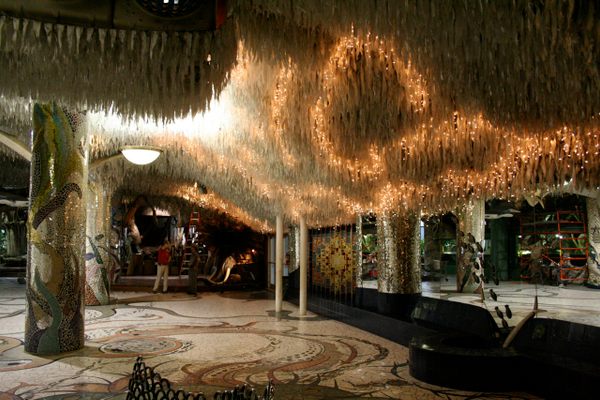Tasmania’s Most Surreal Art Museum Is Also a Cemetery
Unless otherwise stated, images courtesy of the Museum of Old and New Art
Something stinks in Tasmania. “Where else in the world,” I asked myself, pinching my nostrils, “would one of the main cultural attractions be a machine that produces feces?” I was standing uncomfortably close to what has become a major draw at the Museum of Old and New Art: Cloaca Professional, by Belgian artist Wim Delvoye. It simulates the human digestive process — daily feedings yielding deposits of excrement in glass receptacles. I found myself wishing I’d visited the nearby Cadbury chocolate factory instead — not that I felt like eating.
Wim Delvoye’s Cloaca Professional, affectionately known as “the poop machine” (photograph by Doug Beckers)
All day long, tourists and locals cheerfully ask staff to direct them to the “poo machine.” This baffling apparatus is one of many controversial works on display at MONA, the labyrinthine fortress of sandstone and steel that has reshaped the landscape of Tasmania (and transformed the island’s tourism industry) since it opened its doors early 2011 with the largest private art collection in the southern hemisphere.
It’s the $101 million brainchild of David Walsh, Hobart’s resident eccentric multimillionaire, who amassed his vast fortune as a professional gambler and funneled it into sharing his (some say questionable) taste with Tasmania and the world. It’s very much his personal playground — the only art gallery I know of built on a winery (Walsh’s own Moorilla vineyard), with tennis courts at the entrance and peacocks strutting the grounds. Did I mention the indoor trampoline?
Inside MONA (photograph by Rob Taylor)
Take the very arty MONA ROMA ferry across the Derwent River and you’ll arrive at a strange oasis carved out of the Berriedale peninsula. A glass spiral staircase tunnels 17 meters down through three levels of vast sandstone walls and Corten steel columns. Nonda Katsalidis’s enigmatic building, with 6,000 square meters of gallery space, is a marvel even before you start to notice all the freaky art lying around. Who needs to visit the Cadbury factory when you’ve got a suicide bomber’s remains cast in Belgian chocolate?
Not far off, there’s a 1,500-year-old Egyptian sarcophagus whose interior remains are displayed via CAT scans. Some gallery walls are adorned variously with rows of rotting cow carcasses and 151 porcelain vulvas. No divides, no chronology, and no labels – the whole experience of the museum is navigated using “The O” iPhone guide, detecting some 400 exhibits using GPS as you wander past, and imparting what Walsh has termed “Art Wank.”
Bit.fall installation by Julius Popp (Photo by
It makes sense that Walsh, who has a pet cat named Christ and describes himself as a “rabid atheist,” would join forces with undoubtedly the second most eccentric arts lover and public figure in Van Diemen’s Land, Brian Ritchie. The Milwaukee-born bassist of cult indie band the Violent Femmes had been living on the island since 2006, when he approached Walsh to bankroll a music festival reflecting MONA’s eclecticism, experimental bent, and anti-establishment ethos. In 2009 they launched the Museum of Old and New Art Festival of Music and Art – quite a mouthful. With the resulting acronym MONA FOMA pared down to MOFO — conveniently, the slang abbreviation for “motherfucker” — one gets a sense of the founders’ wicked larrikin streak, two Tassie devils on the loose.
Ritchie is far from your run-of-the-mill aging punk rocker. Trained as a master of the Japanese shakuhachi flute (his chosen middle name Tairaku meaning “big music”), he and his wife Varuni opened an improbable zen tea house in central Hobart. As curator of MOFO and the “Dark MOFO” winter edition of the festival, which begins with a public Nude Solstice Swim in the Derwent, Ritchie has brought out the likes of PJ Harvey, the Dresden Dolls, and Elvis Costello while shining the spotlight on indie and local acts — all surrounded by light and sound installations in the gallery and around the city.
After a few hours exploring the museum, you’ll want to re-emerge and take a glass of wine out on the café terrace looking out on the water. No longer perceived by mainlanders as a sleepy, isolated backwater, Tasmania is transforming from its Hicksville reputation into an important global art destination.
If you decide you really like the place and don’t want to leave, you can opt to be exhibited there in an urn. As part of a $75,000 Eternity Membership, your ashes will be interned in style at MONA’s purpose-built columbarium. Walsh’s father — RIP — is already in situ to keep you company. No crematorium on site… yet.
The author playing with the Robin Fox’s Giant Theremin at MOFO 2013
Museum of Old and New Art is at 655 Main Road, Berriedale, Tasmania.
Melissa Lesnie was a guest of Tourism Tasmania and the Museum of Old and New Art during MONA FOMA. She stayed at the Salamanca Inn.



















































Follow us on Twitter to get the latest on the world's hidden wonders.
Like us on Facebook to get the latest on the world's hidden wonders.
Follow us on Twitter Like us on Facebook